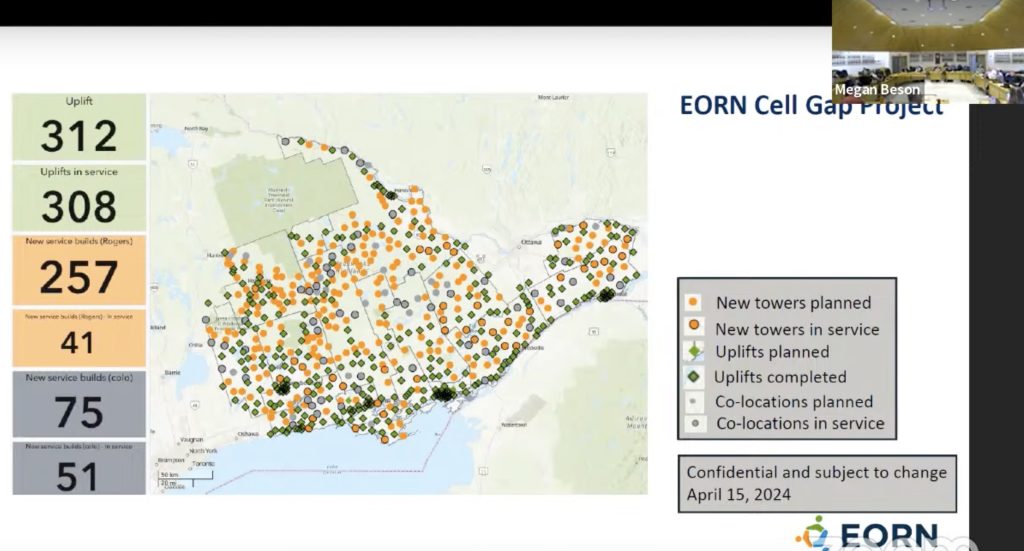Lanark County to see $19.2M in infrastructure builds
LAURIE WEIR
How annoying are dropped calls, slow data speeds and the inability to log into emails or meetings?
Very – but the Eastern Ontario Regional Network (EORN) is working on that.
Lanark County council heard an update on the EORN cell gap project on May 22.
Lisa Severson is the EORN communications director. She gave county council an overview during a presentation to the Economic Development committee.
This is a $300-million investment in eastern Ontario “before in-kind contributions and community benefits,” the document states. There will be an approximate $19.2-million infrastructure investment being made in Lanark County. Broken down, that looks like a $71 million investment from the provincial government, and nearly $71 million from the federal government. Rogers, the private sector partner, is looking at a minimum investment of $150 million. The remaining $10 million is coming from Eastern Ontario Wardens Caucus/Eastern Ontario Mayors Caucus.

Steps to construction will include working with local municipalities. This will take 12 to 24 months to find appropriate locations for towers. Consultation with Indigenous communities and organizations is an ongoing process through the duration of the project.
One of the hardest parts, Severson said, is finding willing landowners.
After negotiating a land use agreement, if a tower is not built on the property within three years, they have to renegotiate with the municipality, Severson noted.
“Service should be provided for everyone,” she said, as they have been working “very closely” with First Nations communities. They are 18 Indigenous communities and organizations with whom EORN has been working over the past 13 months to satisfy the requirements of “meaningful consultation to allow construction to start.”
To date, EORN has done archeological and natural heritage assessments on 178 tower sites.
“We are providing the county with an update (on tower builds) monthly,” Severson said. “Rogers is going really full out right now so expect to hear some good news over the summer with more towers going in service in Lanark County.”
Five new towers should be coming on line in 2024, she said.
The cell gap project is expected to achieve 99 per cent coverage in eastern Ontario where people live, work and travel on major roads so they can make and receive cell phone calls; 95 per cent coverage of standard definition service level that can support email, web browsing and social media services; and 85 per cent coverage to support video conferencing, movie streaming and other data intensive applications.
Warden Steve Fournier asked about that one per cent (or five or 15 per cent) that won’t get coverage and what options would be available.
Severson said in her household, where she works from home in a “dark spot,” a booster has helped.
They will continue with upgrades to existing towers, she said, hoping to get the 312 towers completed by the end of this year. New tower construction will continue through 2026 as will working with Indigenous communities.
“You’ll see periodic (media) releases and we’re hoping for more in-person announcements,” Severson said. “Maybe one can be held in Lanark County.”
Coun. Judy Brown (Perth Mayor) asked about land use authority.
Severson they have already negotiated with landowners and there is a clause in their agreement that if council doesn’t give concurrence or the tower needs to be moved, there are provisions for that. “Then it goes to the local municipality for land use authority,” she said, as some municipalities have a committee for this project, and others would address it during a council meeting.
EORN will often work with staff, and they have to let neighbours in the vicinity of three times the height of the tower what is planned.
“Rogers would be required to post in a local newspaper to notify people,” Severson said. “If you have your own tower citing bylaw or protocol in place you can request public meetings to be held.”
If these protocols are not in place, it reverts back to innovative science and economic development policy around tower citing and there are certain stipulations in that act that an incumbent must do – like posting in the paper and notifying neighbours.
“Rogers would have to answer any concerns or comments that they receive within 30 days,” Severson said, prepare a report and present to municipalities or land use authority committee.
If permission is not granted, Rogers and the Innovation, Science and Economic Development Canada (ISED) would work with municipalities to find a solution.
Once a municipality gives permission, a letter is sent to ISED and construction on the cell tower can begin.






